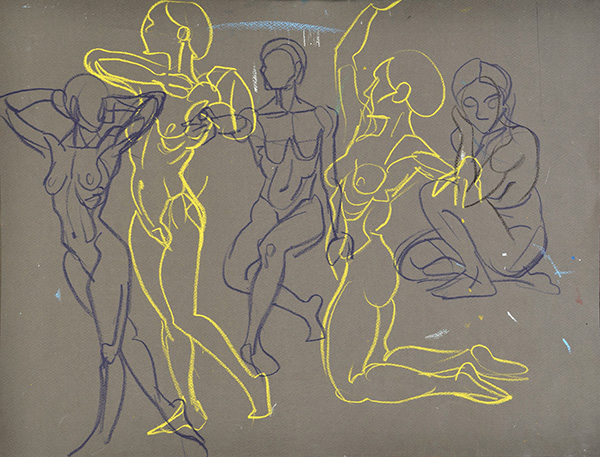One of my all-time most popular Drawing Life posts is “End-On: Extreme Foreshortening“, from 2010, which featured my sketches of models in mostly reclining poses, seen at angles from near head or foot, a view which radically alters the perceived contours and juxtapositions of parts of the body. Many life drawing practitioners find extreme foreshortening very challenging, but if you can learn to analyze what’s in your visual field for this kind of drawing, everything else will be relatively easy. The original post has lots of observations that you may find helpful if you’re trying to learn how to see the figure in perspective. Here is a new set of drawings, all done directly from life without the use of photographs or any optical aids (with the exception of “Linear Man” later in this post, which was drawn while experimenting with a camera lucida).
The body in perspective can be looked at like a landscape, with rises and hollows receding from immediately in front of you to a distant horizon. To render this landscape, let your drawing hand roam over it, feeling the heart quicken as you scale each mound, trying not to lose your footing as you skitter downhill. At the same time, keep the eyes fixed like a surveyor’s transit, noting how each prominence aligns with each other prominence in the conical geometry of the seen scene.
The head-end view of the body is close to what we see if we look down at ourselves, and can express a kind of subjective sense of the body as the physical situation of the mind.
Organic forms are composed of three-dimensional curves, swellings and veerings in space. End-on views of parts of the body give a powerful experience of the swooping flow of such forms. I think of these forms as motions that happen in time. Organic shapes are not defined and constructed, they grow. To grow is to unfold. Unfolding is a motion in time, and every unfolding has its particular arc or waveform.
If we look at the leg, for instance, in a standard standing anatomical position, we see this time-based phenomenon translated into space, like a “timeline of history” chart. This growth that has taken place over time is manifest in the present moment as a particular shape in space. To experience it energetically, we need to translate space back into time. When we see the leg end-on, we can observe this spatial form in cascading cross-sections, experiencing the development of the form as it evolves from moment to moment, in flowing motion.
Hillocks and hollows, nipples and dimples, curves and straightaways, compose the Corpus Humanum.
Dive, and surface. Scale the Alps/Rockies/Andes/Himalayas. Plumb the Marianas Trench.
In the foreshortened world, the knee is a projection of the face, the thighs radiate from the shoulder, and the breast echoes the foot, as shapes related in space, and as parts of the body that contain pulsing hearts.
Slap the feet, gather the pelvis, stoke the gut, radiate the heart, open the throat, illuminate the dome.
Moving up the body from the feet is moving through a springy helix that curls around the ball and arch of the foot and swells out and eddies inward, the lines crossing and crossing again, a mighty and euphonious chord made of living matter.
The vessels of blood and the nerves of impulse are the highways and subways of the body. In observing the body, I try to simplify all that traffic, to intuit from it the arteries of spirit and the veins of mortality.
The centerline of the body is the trunk line. The limbs are byways, regional roads to the dirt farms and bordellos of the outer empire. Peripheral, yet vital. The way the limbs move in relation to the trunk defines the character of the living body.
Oxygen . Carbon . Hydrogen . Nitrogen . Calcium . Phosphorus . Potassium . Sulfur . Sodium . Chlorine . Magnesium .
The spark of life vivifies the carcass. The animal enjoys and suffers the experience of the world. By this experience it is honed and culled, and its wisdom is reproduced.
The form of the body is sacred geometry, but unlike abstract geometry, it is not best rendered with straightedge and compass. It is better apprehended through intuitive senses: rhythm and flow.
Moving down through the body from the head end, one passes through the dome of the cranium, the barrel of the chest, and the vectors of the jointed limbs.
Here’s a foreshortened pose that is not a reclining pose. This is a view of the standing figure from beneath, as observed, upside-down, in a mirror placed on the floor.
Below, a magnetic vortex of foreshortened figures. The void attracts you. Go deep. There are three spatial dimensions, plus time, which is light.
Besides “End-On Part 1“, other posts that include my drawings of the foreshortened body include “A Torso Even More So“, “Reclinging, Not Boring“, and “The Body Contemplated“.
Most of the drawings pictured here are drawn with aquarelle crayons on paper, in the size range of 18″ x 24” (46 x 61 cm). “Vanishing Point” and “Check Mark” are 38″ x 50″ (97 x 127 cm). “Rotation” is 36″ x 36″ (91 x 91 cm), and “Linear Man” is 9″ x 12″ (23 x 30 cm). All are drawn directly from life without the use of photographs.









































































